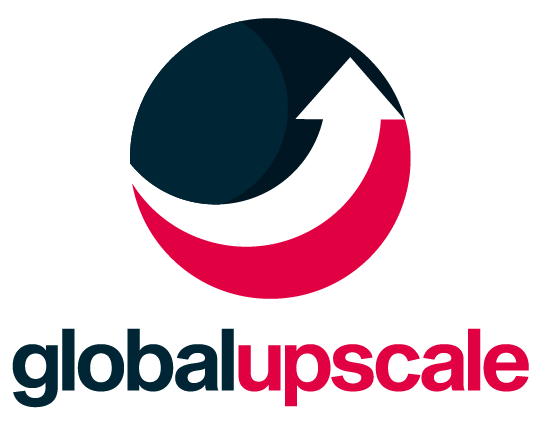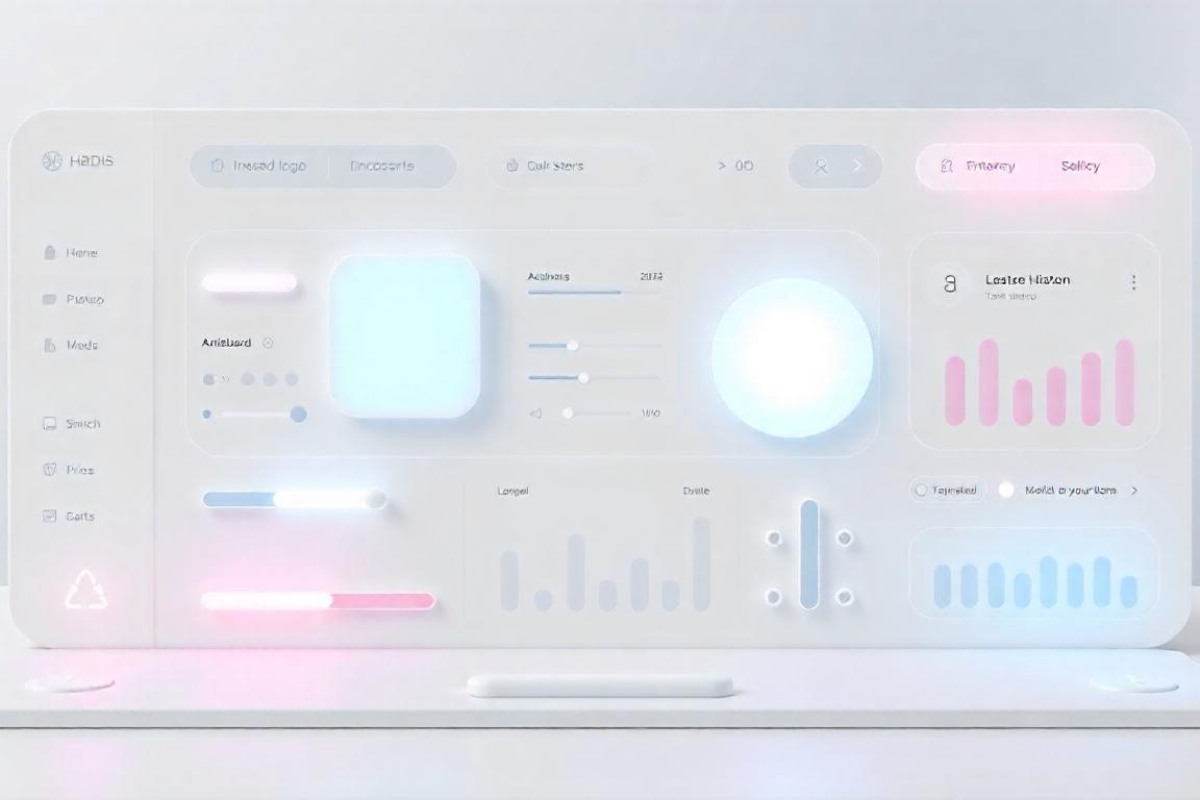Neumorphism, a UI design trend that emerged in 2019, has gained significant traction and is poised to be a dominant force in 2025. This approach combines skeuomorphism and flat design to create soft, tactile, and almost three-dimensional interfaces, making digital elements feel more lifelike and touchable.
Neumorphism improves visual appeal and usability by giving UI components a realistic depth and texture, bridging the gap between the digital and physical.
According to Google Trends, interest in the term “Neumorphism” has steadily increased since it was first coined in 2019, reflecting its growing popularity among designers and businesses seeking to create engaging user interfaces.
However, while Neumorphism offers a fresh and eye-catching aesthetic, it presents challenges concerning accessibility. The subtle contrasts and reliance on shadows can make it difficult for users with visual impairments to interact with neumorphic elements. Therefore, designers must balance visual appeal and usability, ensuring that interfaces are attractive and accessible to all users.
As we move into 2025, Neumorphism is set to shape UI design trends further, giving businesses new ways to create engaging and user-friendly digital experiences. By carefully adding neumorphic web design features, companies can make their digital interfaces more appealing and resemble the tactile feel of real-world objects.
What is Neumorphism? Its History and Origins
Neumorphism, a trend introduced by designers a few years ago, has steadily grown in popularity and shows no signs of slowing down. According to design and industry experts, it’s set to remain one of the hottest trends in 2025.
The reason is simple—Neumorphism brings more life to websites, mobile apps, and UI designs, which is exactly what every business aims for. Blending various UX design elements and technical aspects bridges the physical and digital worlds, making digital platforms feel more real and immersive.
Neumorphism is a modern twist on Skeuomorphism—a design concept made popular by Steve Jobs at Apple. Skeuomorphism mimics real-life objects in digital interfaces, like the Recycle Bin icon, which looks like a trash bin representing where deleted files go.
The Steve Jobs Influence
In 1984, Apple’s Macintosh was one of the first computers to use a graphical user interface, and Skeuomorphic Design played a big role in its user experience. Steve Jobs believed that creating icons and designs resembling real-world objects would make it easier for users to understand how to use the Macintosh.
This approach worked brilliantly. Over time, Apple perfected Skeuomorphism by designing icons and symbols almost identical to real objects. When Mac OS X was released, Apple had developed a rich visual language with detailed icons, shiny effects, and functional menus.
However, the rise of smartphones has brought challenges to skeuomorphism. Smaller screens made it harder to display detailed designs, and making every icon resemble a real object wasn’t always practical. This led to the rise of Flat Design, which used simple lines, curves, and solid colors. Flat Design was easier to create and clean and worked well on small screens.
As digital design evolved, a new version of Skeuomorphism emerged- Neumorphism. It blends the realistic feel of Skeuomorphism with the simplicity of Flat Design. Neumorphism creates a balanced look using soft colors, shadows, textures, raised shapes, and rounded edges. This design style makes digital elements feel lifelike without overly complex, striking a perfect mix of realism and minimalism.
[Also read: 20 Logo Design Inspirations for a Strong Brand Identity]
Neumorphism vs. Other Design Trends
When comparing Neumorphism vs. Skeuomorphism, the key difference lies in their approach to realism. Skeuomorphism, popularized by early Apple designs, mimics real-world objects with intricate details, making digital interfaces feel familiar. Think of the old “Recycle Bin” icon that looks like a trash can.
Neumorphism, however, takes a subtler approach. It borrows the tactile essence of Skeuomorphism but blends it with modern minimalism. By using soft shadows, rounded edges, and monochromatic color schemes, Neumorphism creates a refined, understated realism. While Skeuomorphism can feel outdated and overly detailed, Neumorphism balances realism and simplicity, making it a contemporary alternative.
Neumorphism vs Glassmorphism is another common debate among designers offering distinct aesthetics and experiences. Neumorphism focuses on creating soft, 3D-like visuals using gradients, shadows, and highlights, which give elements a tactile and realistic feel. In contrast, Glassmorphism emphasizes transparency and blur effects, mimicking frosted glass surfaces. This creates a sleek, layered look, often paired with vibrant colors and semi-transparent backgrounds.
While Neumorphism is ideal for creating a cozy, tactile interface, Glassmorphism shines in scenarios where a futuristic and dynamic visual style is desired. Both trends have unique strengths, but their application depends on the intended user experience and the overall design goals.
On the other hand, Flat Design prioritizes simplicity and functionality over aesthetics. It relies on bold colors, clean lines, and minimal details, making interfaces straightforward but less engaging. While Flat Design is highly accessible and easy to implement, it lacks the visual depth that Neumorphism offers.
As a broader trend, minimalism focuses on stripping away unnecessary elements to achieve a clean and uncluttered look. Neumorphism incorporates minimalism but adds depth and texture through carefully crafted shadows and highlights, making designs visually appealing while maintaining simplicity.
What sets Neumorphism apart is its ability to create a sense of interaction by simulating physical touch. However, it still faces challenges, such as accessibility and adaptability to smaller screens, which Flat Design and Minimalism handle more effectively.
Popular Use Cases for Neumorphism in 2025
Neumorphism has become an increasingly popular design trend in 2025, as it creates modern, tactile, and interactive interfaces with soft shadows and 3D effects. This design technique is gaining traction among some well-known brands for its ability to enhance user experience by making interfaces feel more lifelike. Here are some modern neumorphism design examples.
- Apple – Apple has incorporated Neumorphism into their iOS apps, utilizing soft shadows and 3D effects to make buttons, sliders, and cards look more interactive. This design helps their apps feel clean and easy to navigate, creating a modern and sophisticated user interface.
- Spotify – Spotify has embraced Neumorphism in its app design, particularly in its interface elements like buttons and volume sliders. Soft shadows and raised effects make it easier for users to interact with the app, creating a more immersive experience.
- Fintech and Health Apps – Neumorphism 2.0 is becoming popular in fintech and health-related apps, where trust and usability are paramount. The soft, inviting feel of the design makes the user interface feel approachable and easy to interact with.
- Sony – Sony uses Neumorphism to design interfaces that have a soft, tactile effect, enhancing user interactions, particularly in music and gaming apps
- Reddit – As a social platform, Reddit has started integrating Neumorphism for its interactive elements, using soft shadows and depth to give buttons and cards a more lifelike appearance.
- Nike – Nike’s mobile and web apps benefit from the subtle use of Neumorphism, where interactive elements like shopping buttons and product filters feel functional and aesthetically pleasing.
These brands leverage Neumorphism to combine aesthetics with functionality, creating user-friendly, visually appealing interfaces that provide an intuitive experience. The minimalist nature of Neumorphism, combined with its realistic 3D effects, helps users feel more connected to the digital interface.
Gen Z’s Influence and Future of Neumorphism
Neumorphism’s rise reflects the unique preferences of Gen Z design trends, a generation deeply attuned to aesthetics, technology, and interactive digital experiences. Gen Z’s love for creative and immersive designs is expected to play a big role in shaping Neumorphism’s future. Since this generation values inclusivity, future Neumorphism versions will likely focus on being more accessible and user-friendly while keeping its unique look intact. This evolution could help digital platforms combine style and functionality in a way that appeals to a wide range of users.
Will Neumorphism Become Mainstream?
While Neumorphism is captivating and offers a distinct, futuristic look, it also presents challenges. Usability issues such as low contrast and accessibility limitations remain significant barriers. These flaws make it less practical for widespread adoption, particularly in platforms that prioritize universal accessibility. Despite these challenges, Neumorphism is not a fleeting trend. It is a stepping stone in UX design, likely to evolve and inspire new iterations addressing its limitations.
Neumorphism’s integration into digital design will focus on refining the balance between its hyperrealistic, 3D elements and minimalistic simplicity. Innovations could involve the following.
- Improved Accessibility: Future designs may adopt higher contrast, textured borders, or adaptive color schemes to meet accessibility standards while retaining the essence of Neumorphism.
- Enhanced Tactility: Gen Z’s love for interactive designs may drive advancements in haptic feedback, making digital elements feel even more “real.”
- Specialized Use Cases: Neumorphism may find its niche in gaming interfaces, music apps, or niche tools such as remotes and calculators, whose tactile appearance complements functionality.
Conclusion
At Global Upscale, we have expertise in working on both skeuomorphic and neumorphic design projects. Our secret to successfully navigating the skeuomorphism vs. neumorphism debate lies in prioritizing user needs while ensuring exceptional usability. We thoughtfully incorporate classic skeuomorphic cues into designs when they enhance intuitiveness. At the same time, we leverage the subtlety of neumorphic elements to craft sleek, modern, and clutter-free interfaces that resonate with contemporary aesthetics.Interested in our approach and how we can help your project? Contact us today to learn more about our design process!



